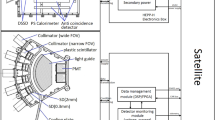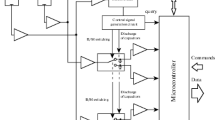Abstract
Based on the knowledge and related theory of earth’s radiation belt, the data of energetic particles observed by detectors onboard ‘CBERS-1’ satellite at a solar synchronous orbit were analyzed. It is proved that the observational results are in agreement with the theoretical description of the radiation belt structures. Analysis of more than 3 years’ data showed clearly that under quiet solar conditions, at a height of about 800 km the energetic particles were mainly located in three regions: northern auroral belt (40°–80°), southern auroral belt (−40°–−80°) and South Atlantic Geomagnetic Anomaly Region (SAA). Actually, this is for the global distribution, at each longitude the latitudinal coverage is much narrower and particles are along the geomagnetic latitude of about ±60°. The species of particles in different regions and their counting rates are different. In SAA, usually both electrons and protons are observed, which should come from inner radiation belt; in polar regions only energetic electrons are observed under the quiet condition, which belongs to the outer radiation belt. The distribution of outer radiation electrons is asymmetrical for longitudes as well as northern and southern polar regions. These asymmetries can be explained with the reflecting altitudes of the mirror points of charged particles at the same L shell.
Similar content being viewed by others
References
Baker D N, Allen J H, Kanekal S G, et al. Disturbed space environment may have been related to Page satellite failure, Eos Trans AGU, 1998, 79(40): 477
Dyer C S, Truscott P R. Cosmic radiation effects on avionics. Microproc Microsyst, 1999, 22: 477
Sawyer D M, Vette J I. AP8 Trapped Proton Environment for Solar Maximum and Solar Minimum. NSSDC WDC-A-R&S 76-06, NASA-GSFC, 1976
Vette J I. The AE-8 Trapped Electron Model Environment, NSSDC/WDC-A-R&S Report 91-24, NASA-GSFC, 1991
Li X, Baker D N, Temerin M, et al. Are energetic electrons in the solar wind the source of the outer radiation belt? Geophys Res Lett, 1997, 24: 923
Li X, Baker D N, Temerin M, et al. Energetic electron injections into the inner magnetosphere during the Jan. 10–11, 1997 magnetic storm. Geophys Res Lett, 1998, 25: 2561
Li X, Baker D N, Temerin M, et al. Rapid enhancements of relativistic electrons deep in the magnetosphere during May 15, 1997 Magnetic Storm. J Geophys Res, 1999, 104: 4467
Li X, Baker D N, Kanekal S G, et al. Long term measurements of radiation belts by SAMPEX and their variations. Geophys Res Lett, 2001, 28: 3827
Selesnick R S, Blake J B. Dynamics of the outer radiation belt. Geophys Res Lett, 1997, 24: 1347
Xiao Z, Zou J Q, Zou H, et al. Energetic particle detector onboard ZY-1 satellite. Acta Sci Nat Univ Pek (in Chinese), 2003, 39(3): 361–369
Zou H, Xiao Z, Wu Z X, et al. Energetic particle event detected by polarorbited satellite at the height of 780 km. Acta Sci Nat Univ Pek (in Chinese), 2003, 39(3): 370–374
Zou H, Xiao Z, Zou J Q, et al. A comparison between detections of energetic electron by ZY1/CBMC and SZ2/XD. Chin J Geophys (in Chinese), 2004, 47(4): 562–570
Ma Y Q, Wang H Y, Zhang C M, et al. A conjunctive study of solar flare 20010402 and related solar proton events by the observation of SZ2/XD and ZY1/CBMC, Chin J Geophys (in Chinese), 2004, 47(5): 737–742
Northrop T G, Teller E. Stability of the adiabatic motion of charged particles in earth’s field. Phys. Rev, 1960, 117: 215
McIlwain C E. Coordinates for mapping the distribution of magnetically trapped particles. J Geophys Res, 1961, 66: 3681
Albert J M, Ginet G P, Gussenhoven M S. CRRES observations of radiation belt proton 1. Data overview and steady radial diffusion. J Geophys Res, 1998, 103: 9261
Lyons L R, Thorne R M. Equilibrium structure of radiation belt electrons. J Geophys Res. 1973, 78: 2142
Gussenhoven M S, Mullen E G, Violet M D. Solar particle events as seen on CRRES. Adv Space Res, 1994, 14: 619
Desorgher L, Buhler P, Zehnder A, et al. Outer radiation belt variations during 1995. Adv Space Res, 1998, 22: 83
Williams J. A 27-day periodicity in outer zone trapped electron intensities. J Geophys Res. 1966, 71: 1815
Hess W N. The earth’s radiation belt. Handbuch der Physik XLIX/4, 1968, 115
Abel B, Thorne R M, Vampola A L. Solar cyclic behavior of trapped energetic electrons in earth’s inner radiation belt. J Geophys Res, 1994, 99: 19427
Tsyganenko N A. A magnetospheric magnetic field model with a warped tail plasma sheet. Planet Space Sci, 1989, 37: 5.
Buhler P, Desorgher L, Zehnder A, et al. Observations of the low earth radiation environment from Mir. Radiat Meas, 1996, 26: 917
Author information
Authors and Affiliations
Corresponding author
Rights and permissions
About this article
Cite this article
Zou, H., Xiao, Z., Hao, Y. et al. Analysis of the observation of particle detector inside ‘CBERS-1’ satellite under solar quiet conditions. SCI CHINA SER E 49, 342–357 (2006). https://doi.org/10.1007/s11431-006-0342-9
Received:
Accepted:
Issue Date:
DOI: https://doi.org/10.1007/s11431-006-0342-9




